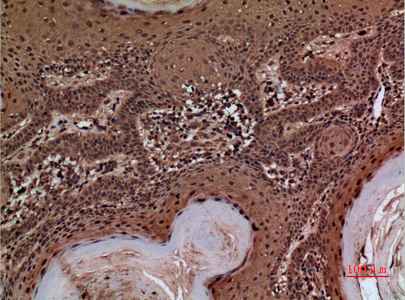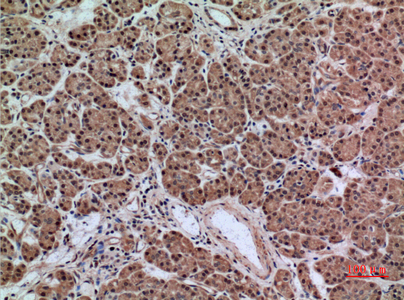AACT Polyclonal Antibody
- Catalog No.:YT5391
- Applications:WB;IHC;IF;ELISA
- Reactivity:Human
- Target:
- AACT
- Gene Name:
- SERPINA3
- Protein Name:
- Alpha-1-antichymotrypsin
- Human Gene Id:
- 12
- Human Swiss Prot No:
- P01011
- Immunogen:
- The antiserum was produced against synthesized peptide derived from the Internal region of human SERPINA3. AA range:251-300
- Specificity:
- AACT Polyclonal Antibody detects endogenous levels of AACT protein.
- Formulation:
- Liquid in PBS containing 50% glycerol, 0.5% BSA and 0.02% sodium azide.
- Source:
- Polyclonal, Rabbit,IgG
- Dilution:
- WB 1:500 - 1:2000. IHC: 1:100-1:300. ELISA: 1:20000.. IF 1:50-200
- Purification:
- The antibody was affinity-purified from rabbit antiserum by affinity-chromatography using epitope-specific immunogen.
- Concentration:
- 1 mg/ml
- Storage Stability:
- -15°C to -25°C/1 year(Do not lower than -25°C)
- Other Name:
- SERPINA3;AACT;GIG24;GIG25;Alpha-1-antichymotrypsin;ACT;Cell growth-inhibiting gene 24/25 protein;Serpin A3
- Observed Band(KD):
- 46kD
- Background:
- The protein encoded by this gene is a plasma protease inhibitor and member of the serine protease inhibitor class. Polymorphisms in this protein appear to be tissue specific and influence protease targeting. Variations in this protein's sequence have been implicated in Alzheimer's disease, and deficiency of this protein has been associated with liver disease. Mutations have been identified in patients with Parkinson disease and chronic obstructive pulmonary disease. [provided by RefSeq, Jul 2008],
- Function:
- caution:It is uncertain whether Met-1 or Met-4 is the initiator.,disease:Defects in SERPINA3 may be a cause of chronic obstructive pulmonary disease (COPD) [MIM:107280].,domain:The reactive center loop (RCL) extends out from the body of the protein and directs binding to the target protease. The protease cleaves the serpin at the reactive site within the RCL, establishing a covalent linkage between the carboxyl group of the serpin reactive site and the serine hydroxyl of the protease. The resulting inactive serpin-protease complex is highly stable.,function:Although its physiological function is unclear, it can inhibit neutrophil cathepsin G and mast cell chymase, both of which can convert angiotensin-1 to the active angiotensin-2.,miscellaneous:Alpha-1-antichymotrypsin can bind DNA.,online information:Alpha-1 antichymotrypsin entry,sequence caution:Translation N-terminally shortened.,si
- Subcellular Location:
- Secreted.
- Expression:
- Plasma. Synthesized in the liver. Like the related alpha-1-antitrypsin, its concentration increases in the acute phase of inflammation or infection. Found in the amyloid plaques from the hippocampus of Alzheimer disease brains.
Subtype and prognostic analysis of immunogenic cell death-related gene signature in prostate cancer. Wei Yong WB Human C4-2 cell,RWPE-1 cell
- June 19-2018
- WESTERN IMMUNOBLOTTING PROTOCOL
- June 19-2018
- IMMUNOHISTOCHEMISTRY-PARAFFIN PROTOCOL
- June 19-2018
- IMMUNOFLUORESCENCE PROTOCOL
- September 08-2020
- FLOW-CYTOMEYRT-PROTOCOL
- May 20-2022
- Cell-Based ELISA│解您多样本WB检测之困扰
- July 13-2018
- CELL-BASED-ELISA-PROTOCOL-FOR-ACETYL-PROTEIN
- July 13-2018
- CELL-BASED-ELISA-PROTOCOL-FOR-PHOSPHO-PROTEIN
- July 13-2018
- Antibody-FAQs
- Products Images

- Western Blot analysis of 4T1 cells using AACT Polyclonal Antibody. Secondary antibody(catalog#:RS0002) was diluted at 1:20000 cells nucleus extracted by Minute TM Cytoplasmic and Nuclear Fractionation kit (SC-003,Inventbiotech,MN,USA).

- Immunohistochemical analysis of paraffin-embedded human-skin, antibody was diluted at 1:100

- Immunohistochemical analysis of paraffin-embedded human-pancreas-cancer, antibody was diluted at 1:100



